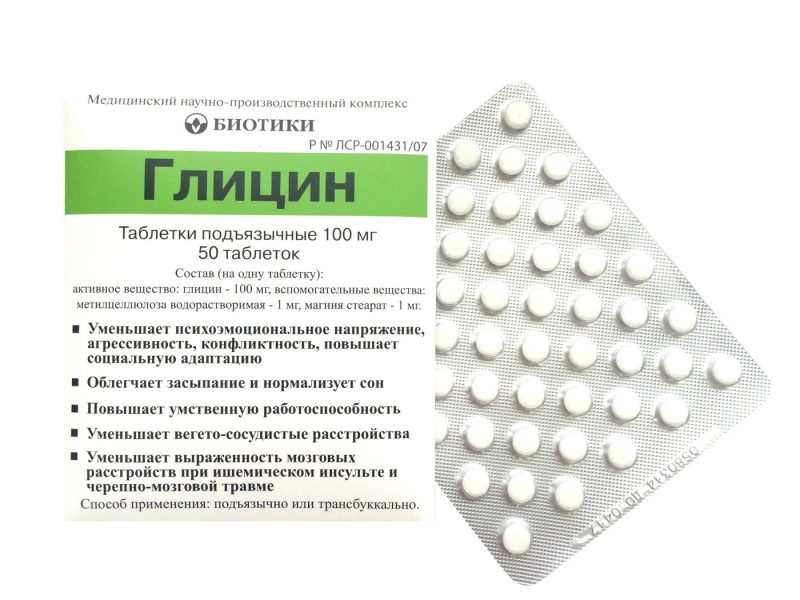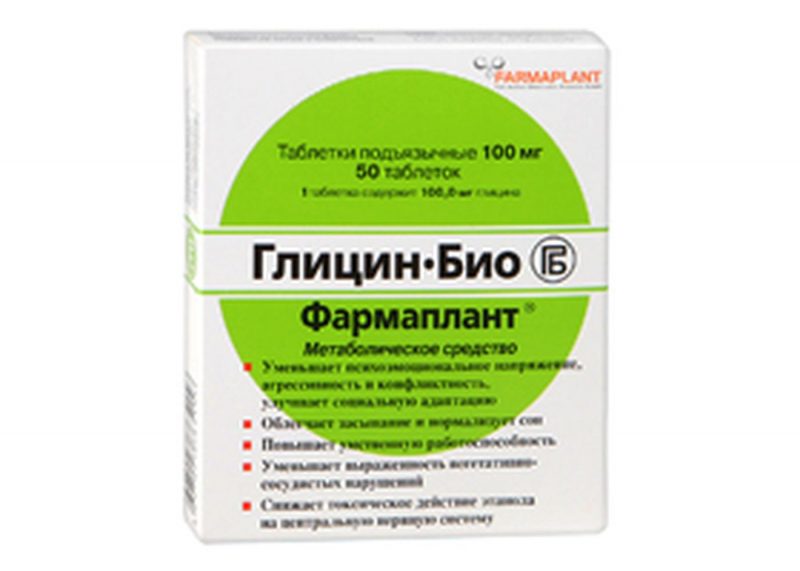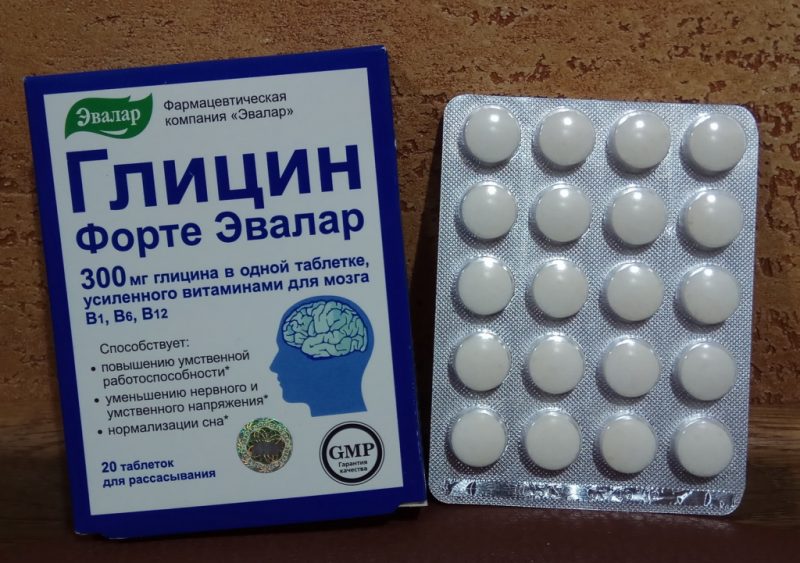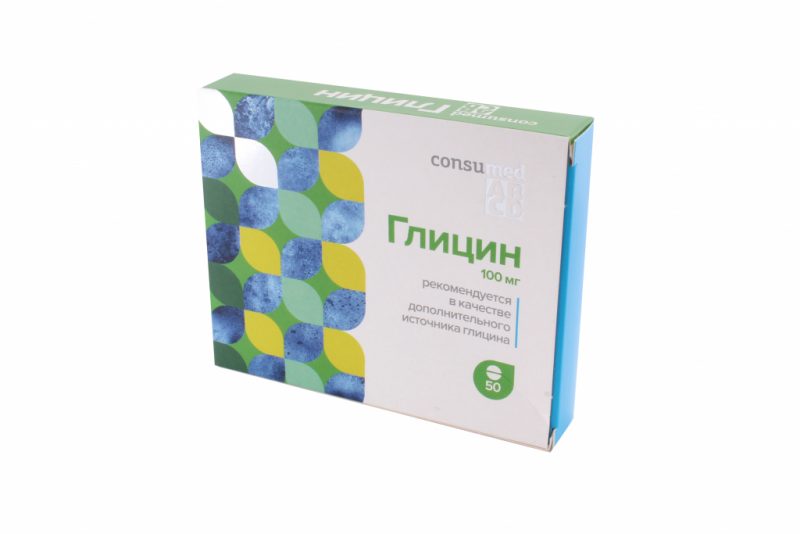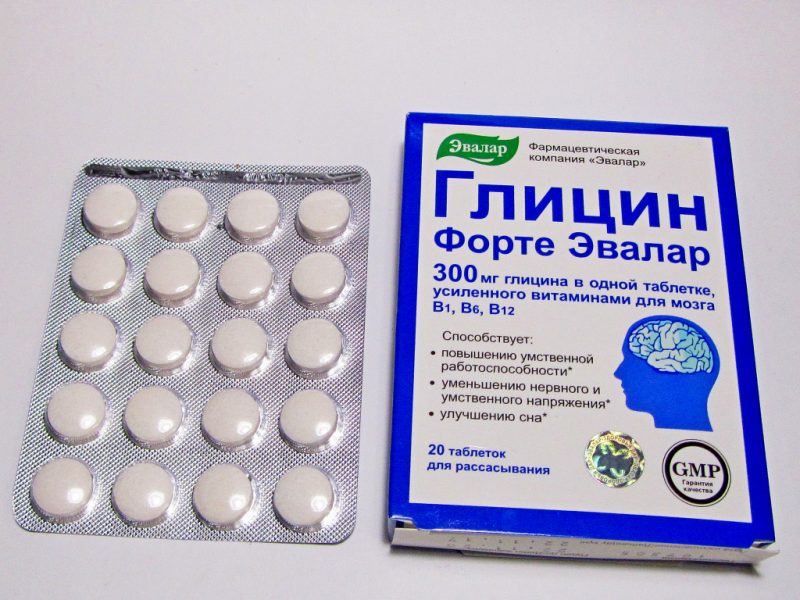To improve mental performance, normalize memory and resist stress, doctors recommend taking an affordable and safe remedy. The drug "Glycine": what is it for, what it consists of, how to use it correctly, are there any contraindications for use?
Material Content:
Composition, release forms
The drug consists of aminoacetic acid, an important substance that our body produces on its own.
It is necessary for the regulation of a large number of processes, especially of a neurohumoral nature. Glycine contributes to a calm state of a person, the normal functioning of the brain and nervous system as a whole.
Lack of this substance leads to health problems, which are expressed in chronic fatigue, inability to concentrate, forgetfulness, temper, and irritability.
You can fill the deficiency with the help of foods that contain aminoacetic acid:
- dairy products, cheese;
- fish, meat;
- legumes, cabbage, soy, cucumbers;
- kiwi, bananas;
- nuts
- fennel, basil;
- jelly, jelly, marmalade;
- the eggs.
A convenient and affordable way to replenish the body with the necessary acid - white tablets "Glycine", a little sweet in taste. The network of pharmacies presents dosages of pills of 150, 400 and 500 mg. They are intended for sublingual administration, that is, they must be placed under the tongue and resolved.
The composition of the drug, in addition to the active substance, includes:
- magnesium stearate;
- methyl cellulose.
The package contains 50 tablets.
Pharmacological properties and pharmacokinetics
After use, the drug is rapidly absorbed, has a therapeutic effect and is excreted from the body, disintegrating into water and carbon dioxide. Due to these characteristics, Glycine is considered a particularly safe and fast-acting agent.
What is this type of amino acid in the body responsible for? First of all, it affects the nervous system, providing its adaptive characteristics. The difficult stressful conditions in which today almost everyone is from birth, require increased protection within the body. It is glycine that helps to improve psycho-emotional health.
The functions of aminoacetic acid are:
- control of metabolic processes;
- increasing the functionality of the protective processes of the central nervous system;
- improved brain function;
- stimulation of mental activity;
- decrease in nervous tension;
- memory improvement and concentration;
- assistance in adaptation in society;
- suppression of excessive aggressiveness, conflict;
- normalization of sleep;
- reduction in the toxic effects of alcohol and medicines;
- mood improvement;
- getting rid of the symptoms of VVD, menopause in women;
- minimizing the effects of head injuries, stroke;
- increase in vitality.
If the body produces a sufficient amount of acid, then problems with pathologies of this nature do not arise. But in case of deficiency, an additional supply of glycine from the outside is required.
Particularly relevant decision on taking the drug will be for the elderly, students during increased mental stress, as well as athletes during the competition.
Some doctors advise taking the drug to prevent depression, improve brain function and reduce cravings for sweets (as a dietary supplement).
Why is the drug prescribed?
Most receptors that are particularly susceptible to aminoacetic acid are located in the brain, and in all areas responsible for a wide variety of processes. Therefore, among the diseases in which Glycine is prescribed, various deviations in the functioning of the brain and conditions caused by its insufficient activity are called.
The reasons for prescribing the drug are:
- decreased physical activity due to constant fatigue;
- lowering the quality of mental work;
- memory impairment;
- prostate cancer prevention;
- vegetative-vascular dystonia (including menopause in women);
- adolescent or children's transitional crisis period characterized by deviant behavior;
- a protracted period of stress, emotional stress (for example, clarifying personal relationships of a married couple, a student session);
- neurosis and conditions of increased irritability and irritability;
- postpartum brain damage;
- ischemic stroke;
- encephalopathy of various origins (often of alcoholic origin);
- rehabilitation period after traumatic brain injury.
In addition to a direct effect on the efficiency of the brain, the drug stimulates normal metabolic processes and improves the functionality of the liver and kidneys. With the help of Glycine, it is possible to normalize blood sugar levels, the drug also helps to rejuvenate the skin and improve the condition of the hair, contributing to the production of collagen useful for elasticity.
Instructions for use and dosage of glycine
Any medicine requires careful attention to the dosage and rules of administration, even the safest. The doctor prescribes the drug based on the diagnosis and its accompanying symptoms.
Tablets should be placed under the tongue or cheek and dissolve until completely dissolved. Thus, the maximum effect of the drug is achieved. The effectiveness of the action does not depend on food.
The dose depends on the age of the patient. How to take glycine?
For adults
The recommended standard dosage is 1 pill (0.1 g) twice or thrice a day.
According to this scheme, the drug is prescribed for adults to improve the condition with:
- decreased mental activity;
- increased mental stress;
- prolonged stress;
- emotional stress;
- increased aggressiveness;
- anxiety conditions;
- alcohol addiction;
- brain damage;
- toxic encephalopathy.
The course of treatment varies from 7 days to a month, depending on the severity of the symptoms.
To get rid of problems with falling asleep, doctors recommend drinking 1 - 2 tablets of the drug an hour - half an hour before bedtime.
After a stroke, in the next 3 to 5 hours, 10 tablets of Glycine should be dissolved. Then, during the week, another 10 pills should be taken daily, and then within a month the dosage is 3 tablets per day.
For children
To make it convenient to take the drug at this age, it is better to grind the pills to a powder state.
Babies from 2 to 3 years old are given 50 mg of medication 2 to 3 times a day. The course of treatment is 7-14 days. Then therapy can be continued for another 7 days, but with a lower daily dose of 0.05 g.
Children from 3 years old are usually prescribed a two to three-week course of treatment with a drug, consisting of a daily dose of 200–300 mg, which is divided into 2–3 doses to improve attention concentration.
There are some cases where the use of the drug is necessary for babies who are breast-feeding, if they have a deficiency of aminoacetic acid. Then it is prescribed for mother’s reception, it is supplied to the child’s body along with milk and produces the desired therapeutic effect.
Use during pregnancy and lactation
The drug is not only not prohibited for women in a special situation, but is even recommended for use during this period. After all, he has a beneficial effect on the expectant mother, and does not penetrate the fetus through the placenta.
Under the influence of hormonal changes, a woman’s body goes through large-scale changes during pregnancy. The immune, endocrine and nervous systems come under attack in the first place, making the expectant mother emotionally vulnerable. A woman in this position often changes her mood, there is anxiety, irritability.
Glycine successfully copes with such “side effects” of pregnancy, improves the condition and increases the degree of mood.
Doctors recommend that women, while waiting for a child, take 1 tablet of the drug three times a day in the presence of symptoms such as:
- sleep disturbances;
- pressure drops;
- migraine;
- emotional overload;
- increased cholesterol;
- toxic poisoning;
- decreased brain activity;
- epilepsy.
The final decision on the duration of therapy and dosage is up to the doctor.
It is especially necessary to carefully monitor the condition of a woman in the first trimester of pregnancy, without special need not to take the drug.
But the subsequent periods are absolutely safe regarding the use of Glycine by pregnant women.
Drug Interactions with Other Drugs
Due to its natural composition for the body, the tool normally combines in its action with most medicines.
Glycine slightly reduces effectiveness:
- psychotropic drugs - antipsychotics, anxiolytics, antidepressants;
- sleeping pills;
- anticonvulsants.
Contraindications, side effects and overdose
Since the composition of the drug is absolutely natural components for the human body, there are few serious reasons why glycine cannot be taken. It does not have the property of accumulation, is rapidly excreted from the body.
Proof of the safety of the drug is the fact that it is prescribed to pregnant patients, women who breastfeed their children, as well as children starting from two years old.
First of all, as with the use of any other medicines, you need to make sure that a person does not have an allergic reaction to an amino acid or related components of the drug.Indeed, individual intolerance, although rare enough, can happen. If after taking Glycine a rash, itching, or redness appears, you should abandon such therapy and try to replace the medicine with similar medicines in effect.
The use of aminoacetic acid in the composition of medicines is not recommended:
- in children under 2 years old;
- patients with hypotension.
The second contraindication is due to the fact that the drug has the ability to lower blood pressure, which is not necessary for people who already have fairly low blood pressure.
In addition to low pressure, there are several side effects that can occur to varying degrees after taking the medication under discussion.
Among them:
- apathy, lethargy;
- drowsiness;
- general weakness;
- nausea, digestive upset (these symptoms are very rare).
Cases of overdose have occurred infrequently, a slight excess in dosage does not cause dangerous conditions. But you can not deviate from the dose specified in the instructions.
Otherwise, the following symptoms are likely:
- epigastric pain;
- decreased activity;
- sudden fatigue.
In such situations, symptomatic treatment is prescribed: gastric lavage, sorbent intake. If deterioration is observed, an ambulance must be called.
Glycine analogues
Since the active substance is, in fact, the drug itself, only different types of medications can be called analogues of the drug, which differ in the amount of active component, manufacturer and additional components.
Glycine Forte "Evalar" (the name of the pharmaceutical company) has pills of 300 and 600 mg, in addition, it contains B vitamins that enhance the effectiveness of the main drug.
The largest amount of the active component - amino acids - has the medicine Glycine-Canon - 1000 mg. Glycine-Vis contains 400 mg of a healing agent and additionally a vitamin complex.
The glycine-bio version of the drug has 100 mg of aminoacetic acid, as does Glycid.
If we talk not about the synonyms of the drug, but with drugs with a similar pharmacological effect, then the following medications should be distinguished:
- "Phenotropil";
- Mexidol;
- "Antifront";
- glutamic acid;
- "Tryptophan";
- "Cytoflavin";
- Nicomex
They cannot be called similar in nature to the effect on the nervous system, therefore, the use of each of the medicines should be discussed separately with the attending physician in order to avoid undesirable consequences.
The correct dosage and compliance with the rules for the duration of treatment and prevention, will fully reveal the potential of "Glycine." The tool will help normalize the functioning of the nervous system, give calm and good mood.


